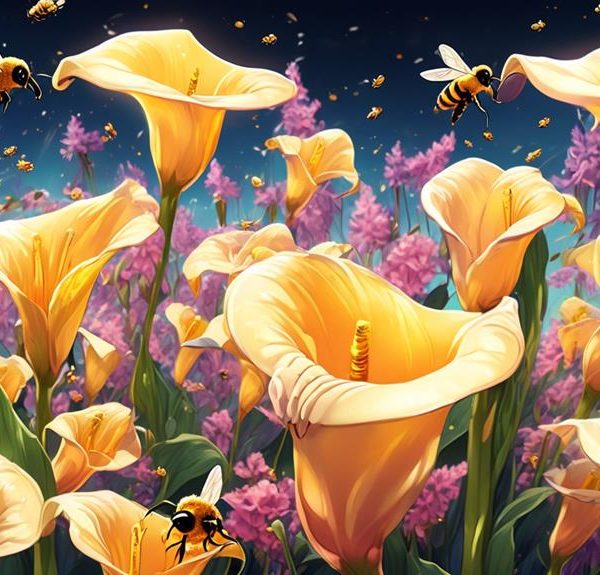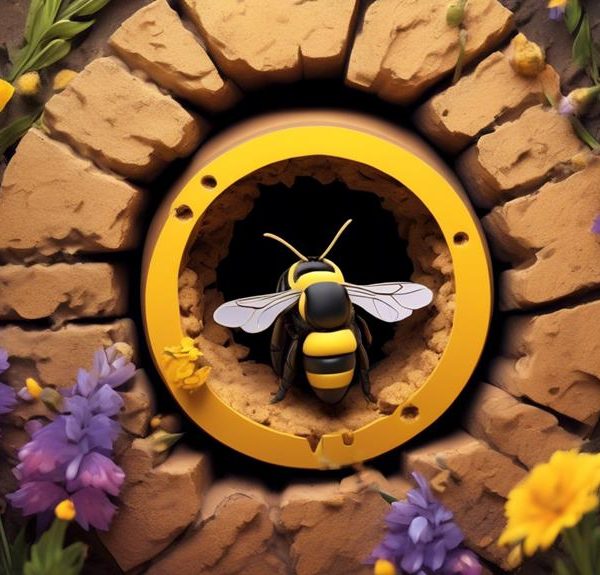Kissed by bees, do camellias hold a secret allure for these buzzing pollinators? Find out more about this fascinating floral fascination.
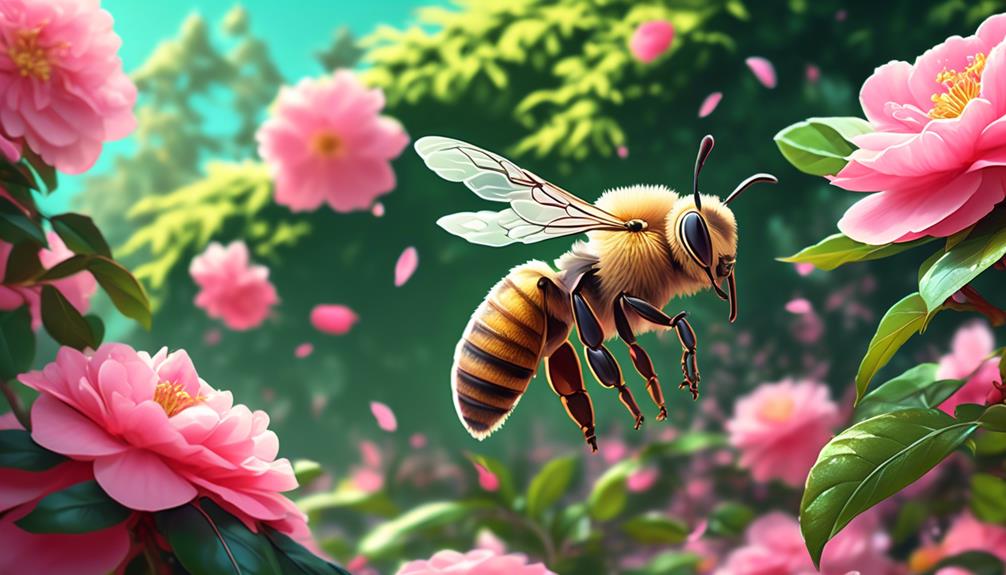
Do Bees Like Camellias
Picture yourself in a tranquil garden, the scent of blooming camellias hanging heavy in the air, their vibrant petals a stark contrast against the lush green backdrop.
As you admire these floral beauties, a soft buzzing sound catches your attention, leading your eyes to a diligent bee, hovering over a camellia. You can't help but ponder, do bees have a particular affinity for camellias? Well, you're not alone in your curiosity.
It's a question that's crossed the minds of many garden enthusiasts and beekeepers alike. Stick around, as we're about to explore the intriguing relationship between these industrious insects and the captivating camellia.
Key Takeaways
- Camellias are attractive to bees due to their vibrant colors, abundant nectar, and open blossoms, making them a valuable nectar source during late winter to early spring.
- Bees play a crucial role in the pollination of camellias, aiding in their reproduction and survival.
- Bees pick up pollen from camellia blooms and transfer it to other flowers, leading to fertilization and the production of seeds.
- Planting a variety of camellia species that thrive in local climate and soil conditions can ensure a year-round supply of nectar for bees.
Understanding Camellias: A Brief Overview
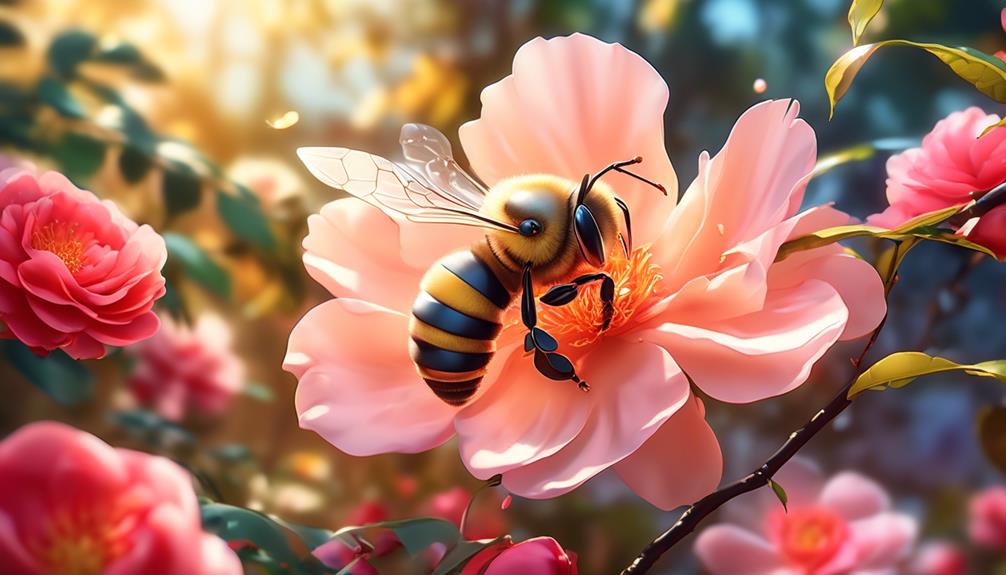
To fully appreciate the relationship between bees and camellias, you need to first understand the intrinsic nature of camellias themselves, which are evergreen shrubs or small trees renowned for their showy, glossy foliage and large, intricate flowers. Originating from eastern and southern Asia, these plants are part of the Theaceae family, closely related to tea plants. They're incredibly adaptable, capable of thriving in various climates and soil conditions, which contributes to their widespread cultivation.
Your analysis of camellias should consider their blooming period which usually spans from fall to spring. During this time, they produce a profusion of blooms that aren't only visually stunning but also laden with nectar and pollen. It's this abundance that turns them into a veritable magnet for bees.
Moreover, you need to acknowledge the variety within camellias. Over 3,000 cultivars exist, each with different flower shapes, sizes, and colors. Some camellias sport single, flat flowers while others boast double, rose-like blooms. This diversity has implications on the types of bees they attract and the extent of their interactions.
Understanding camellias' complexity and appeal to bees is key to grasping the symbiotic relationship they share.
The Attraction Between Bees and Camellias
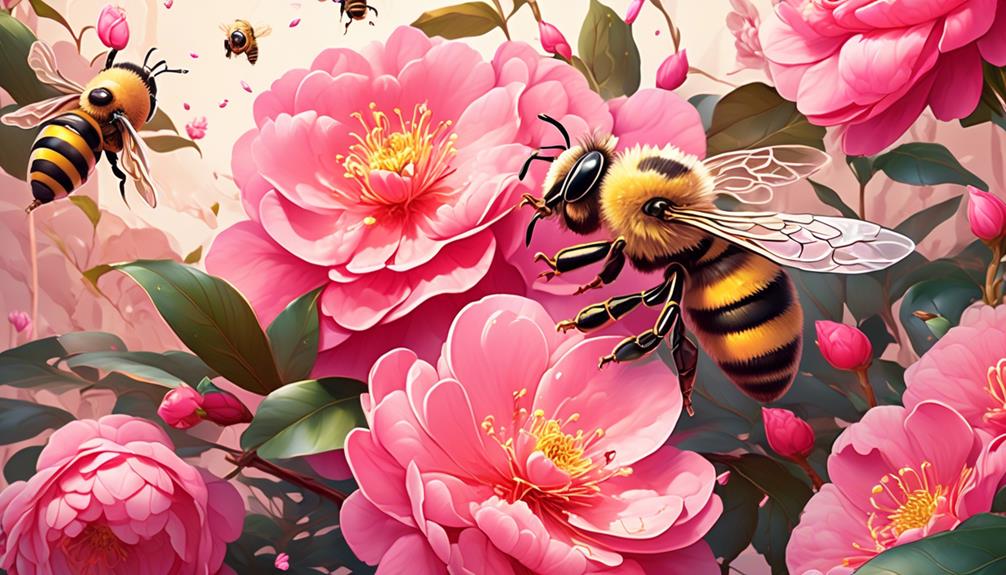
Having explored the nature and diversity of camellias, let's now examine how these floral attributes create a powerful lure for bees. You'll find that camellias' bright, vibrant colors and abundant nectar are irresistible to these buzzing insects.
Camellias' hues, ranging from white to pink and red, stand out in the landscape, attracting bees from considerable distances. Their color intensity is a visual cue for bees, signaling the presence of a potential nectar source.
The structure of camellias also plays a significant role. Their broad, open blossoms provide easy access to bees. Unlike other plants with complex flower structures, bees won't exert much effort to extract nectar from camellias. This efficiency is appealing to bees, enhancing the attraction.
Moreover, the timing of camellias' bloom is another factor. Flowering in late winter to early spring, camellias offer a valuable nectar source when other plant resources may be scarce. This timing coincides with the early foraging activity of bees, making camellias an essential part of their diet.
In the grand scheme, the relationship between bees and camellias is symbiotic. While bees feed on the nectar, they also aid in the plant's pollination, contributing to the propagation of the species.
Role of Bees in Camellia Pollination
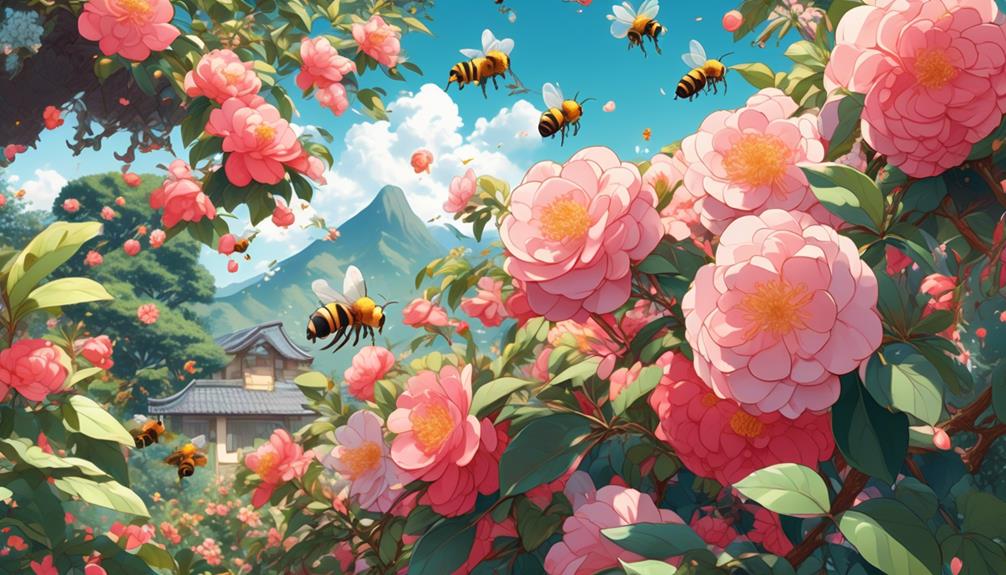
In the complex dance of pollination, bees play a critical role in the life cycle of camellias. As a bee lands on a camellia bloom, it's not just sipping nectar. It's also picking up pollen grains on its body, specifically its hairy legs and abdomen.
When the bee flits to the next flower, some of that pollen rubs off onto the flower's stigma, the part of the female reproductive system in plants. This is how pollination occurs, triggering a process known as fertilization. It's a fundamental part of sexual reproduction in plants, leading to the production of seeds.
For camellias, cross-pollination is key. This species can't self-pollinate, meaning it needs pollen from a different plant of the same species. This is where bees come in. They're the perfect pollinators for camellias because they're attracted to the flowers' vivid colors and sweet nectar, and they visit multiple plants in one outing.
Without bees, camellias would struggle to reproduce. So, when you watch a bee buzzing around your camellia bush, remember: It's not just a visitor. It's an essential worker, helping to ensure the survival and continuation of these beautiful plants.
Planting Camellias to Attract Bees
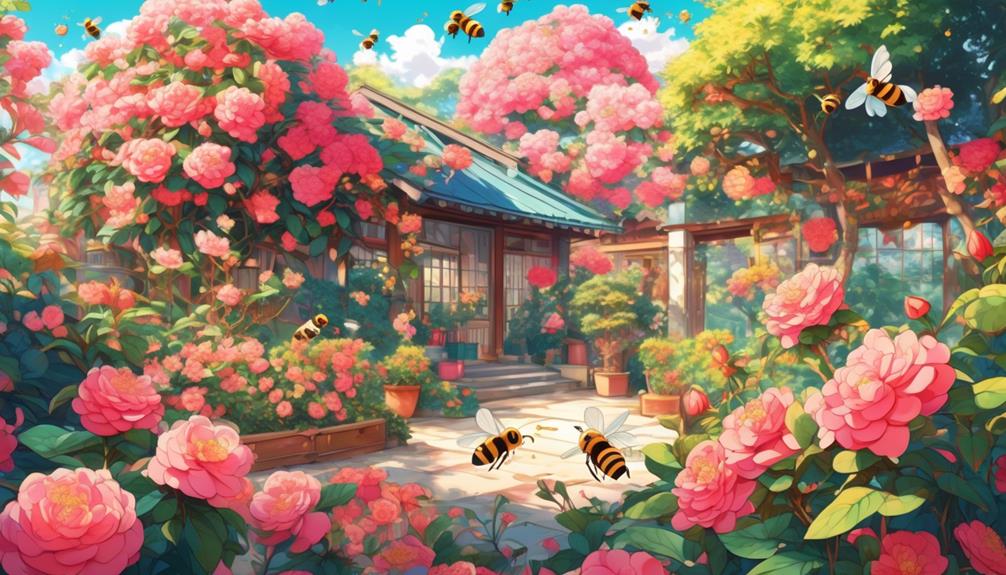
Understanding the vital role bees play in camellia pollination, you might be wondering how you can attract more of these essential workers to your garden. The key lies in understanding the preferences of bees and planting camellias accordingly.
Camellia Variety | Flowering Period | Bee Attraction Level |
|---|---|---|
Camellia Japonica | Winter to Spring | High |
Camellia Sasanqua | Autumn to Winter | Medium |
Camellia Reticulata | Late Winter to Early Spring | High |
Camellia Sinensis | Autumn | Low |
Camellia Williamsii | Mid Winter to Early Spring | High |
Camellia Japonica and Reticulata, with their flowering periods during colder months, provide a vital food source for bees when other options are scarce. Sasanqua, blooming in autumn to winter, and Williamsii, blooming from mid-winter to early spring, also attract bees, albeit to a lesser degree. Sinensis is the least attractive to bees due to its autumn blooming and less nectar production.
Planting a mixture of these camellias ensures a year-round supply of nectar, attracting and sustaining bees in your garden. Remember, choose varieties that thrive in your local climate and soil conditions for optimal results.
Observing Bees Among Camellias
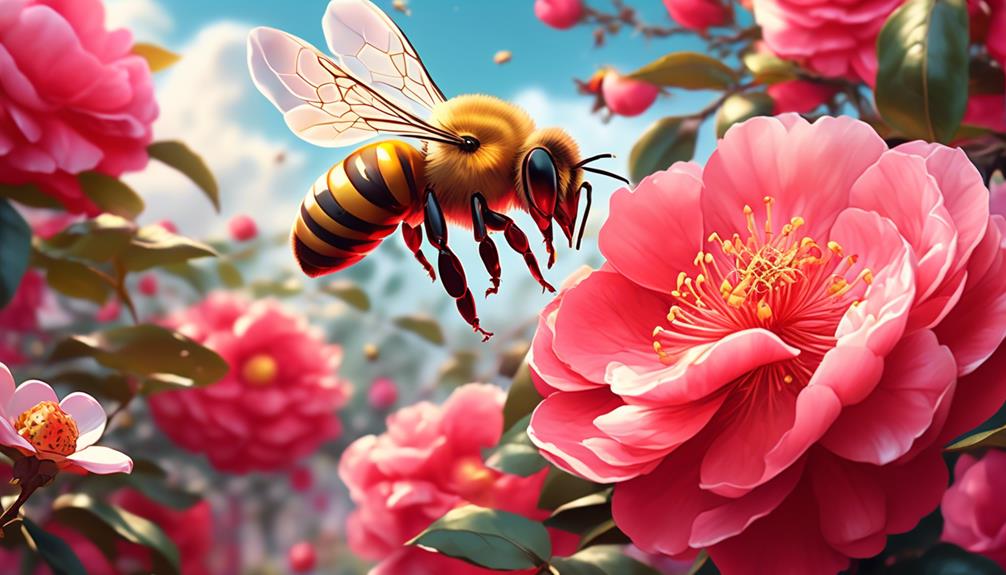
Once you've planted your camellia garden to attract bees, it's crucial to observe these pollinators' interaction with the blossoms to gauge their attraction levels and activity patterns. Equip yourself with a notebook and a keen eye, and begin your observations.
Focus on the bees' behavior. Do they gravitate towards specific camellia varieties? Note the frequency of their visits and the duration of their stay on each blossom. Are they collecting nectar or pollen, or both? These observations can tell you a lot about which camellias are most appealing to them.
It's also vital to observe bees at different periods of the day. Bees' activity patterns can vary, with some species being more active in the morning, while others prefer the afternoon. Similarly, different weather conditions can affect their activity. Record these details meticulously.
Frequently Asked Questions
What Specific Species of Bees Are Most Attracted to Camellias?"
You're specifically asking about the bee species most attracted to camellias. It's primarily the honeybees and bumblebees that are drawn to these plants. They're enticed by the plant's abundant nectar and pollen.
However, solitary bees like mason bees may also show interest. It's important to note that the attraction can vary based on local bee populations and the specific variety of camellia.
How Do Changing Seasons Affect the Relationship Between Bees and Camellias?"
When seasons change, it affects the interaction between bees and camellias.
In spring, you'll see bees flocking to camellia blossoms for nectar.
However, as summer approaches, camellias may stop blooming, causing bees to seek other food sources.
When autumn arrives, the bees hibernate, and so, don't visit the flowers.
Therefore, the changing seasons significantly influence the relationship between bees and camellias.
Are There Any Potential Threats to Bees When They Interact With Camellias?"
There's no evidence to suggest that camellias pose a threat to bees. In fact, they're a great source of nectar and pollen during the colder months.
However, you should be aware that the use of pesticides or other chemicals on the plants can harm bees.
It's recommended to opt for organic gardening methods to ensure the bees can safely enjoy the camellias.
What Other Insects or Animals Are Attracted to Camellias?"
You're not just looking at bees here, other insects are also drawn to camellias. Butterflies and moths often visit for the nectar.
Some birds, like hummingbirds, are attracted to the vibrant colors. Even small mammals such as squirrels may be enticed by the seeds.
However, you'll also find less desirable visitors like aphids and spider mites. So, it's a mixed bag when it comes to which creatures are drawn to your camellias.
In What Regions of the World Are Camellias Most Prevalent and Do They Attract Bees in These Regions?"
Yes, bees are attracted to Camellias, especially in regions where they're most prevalent, such as East Asia and the southern United States. You'll often find bees busily buzzing around Camellias in these regions.
The flowers' bright colors and sweet nectar are irresistible to bees. They're not just pretty to look at, but they're also a vital food source for bees, particularly in late winter and early spring when other food sources are scarce.
Conclusion
In conclusion, bees certainly love camellias. They're drawn to these plants due to the nectar and pollen they provide. In return, bees play a critical role in their pollination.
By planting camellias in your garden, you're not only beautifying the space but also helping the bee population.
So next time you observe bees buzzing around your camellias, know that it's a mutually beneficial relationship at work.

